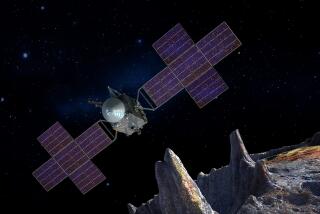This NASA Project Rocks
- Share via
NASA still suffers its share of costly excesses (think International Space Station). But sometimes it does just the right thing. At a press conference Tuesday, NASA officials held up a new probe called Contour--short for Comet Nucleus Tour--scheduled to be launched July 1, as a model of the cost-effective, science-rich missions the agency needs more of. The 2,100-pound, $60-million probe will fly by two comets in an attempt to discover what they are made of.
Scientists hope the mission will help them evaluate the theory that comets once carried to Earth the water and organic materials necessary for life. But there’s a second and more compelling reason to hope that NASA’s Delta rockets safely deliver the black-and-gold satellite into space next month: Contour is the first of several probes NASA is launching to help develop a strategy for the day, considered inevitable in the long run, when a monster asteroid or comet takes aim at Earth.
The second probe, a $279-million spacecraft dubbed Deep Impact, will intercept a comet and use a projectile to blow a huge hole in it to see what’s inside. It is slated for launch in January 2004. Think of the movie potential.
Donald Yeomans, who manages Contour and some of NASA’s other Near Earth Objects missions from his office in Pasadena’s Jet Propulsion Laboratory, explained this week that more than 1,000 large objects capable of striking Earth are circling through the solar system. Only half have been studied even cursorily.
“It pays to know the enemy,” Yeomans pointed out. “If one is coming toward us with our name on it, it makes a big difference in what you are going to do with it, if it is a fluff ball or solid iron.”
This is not to say that NASA has completed its cost-efficiency mission. While Yeomans was briefing reporters Tuesday, two astronauts were attaching a crane to the International Space Station. The U.S. will have spent $23.4 billion by 2004 on the space station. Congress should scrutinize that project to prevent it from becoming a waste. Legislators should, for instance, press NASA to recoup some costs by charging pharmaceutical companies and others hungering to perform zero-gravity studies in its labs. Or if that fails, sell satin bomber jackets with Comet Nucleus Tour 2002 embroidered on the back. They’d be huge.






